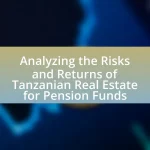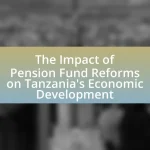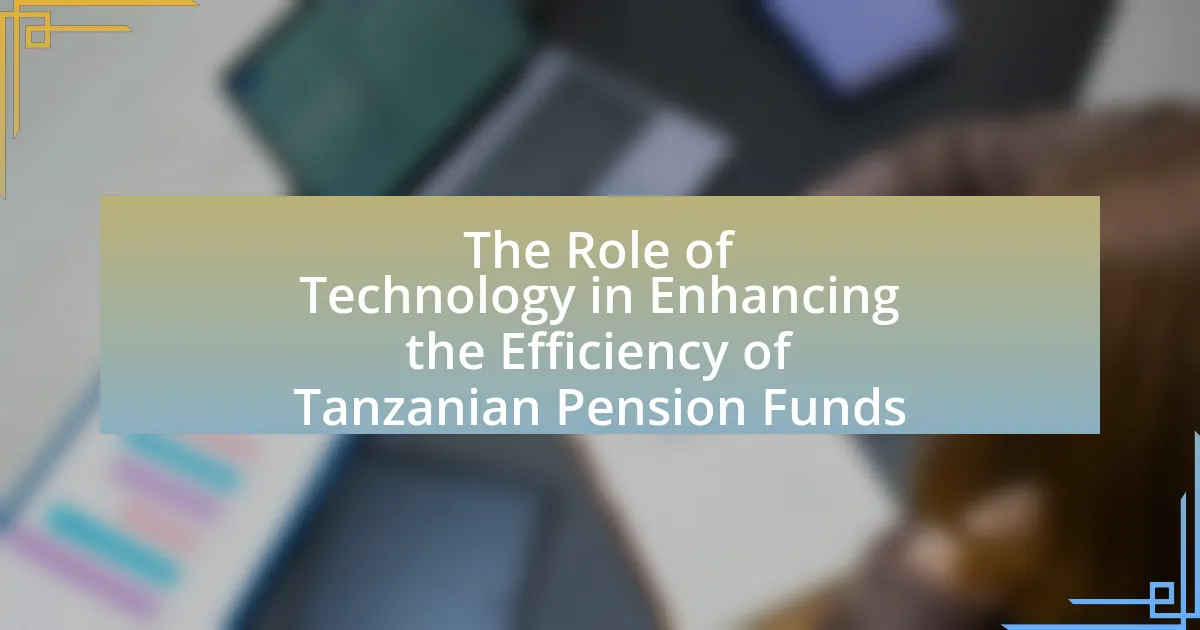The article focuses on evaluating the returns on investment for Tanzanian pension funds, highlighting key factors such as asset allocation, regulatory environment, economic conditions, and investment management practices. It examines how economic indicators like inflation and GDP growth impact fund performance, and discusses the role of regulations in shaping investment strategies. Additionally, the article outlines common asset classes for pension funds, the importance of diversification, and strategies for optimizing returns, including active management approaches. It also addresses challenges in measuring performance and provides practical tips for pension fund managers to enhance investment outcomes.

What are the key factors influencing the returns on investment for Tanzanian pension funds?
The key factors influencing the returns on investment for Tanzanian pension funds include asset allocation, regulatory environment, economic conditions, and investment management practices. Asset allocation significantly impacts returns, as pension funds diversify investments across equities, bonds, and real estate to optimize risk and return. The regulatory environment in Tanzania, governed by the Pension Act, affects investment strategies and limits on asset classes, influencing overall performance. Economic conditions, such as inflation rates and GDP growth, directly affect the financial markets in which these funds invest, impacting returns. Lastly, effective investment management practices, including the selection of fund managers and their strategies, play a crucial role in achieving favorable returns.
How do economic conditions impact the performance of pension funds in Tanzania?
Economic conditions significantly impact the performance of pension funds in Tanzania by influencing investment returns and fund liquidity. For instance, high inflation rates can erode the real value of returns, while economic growth can enhance investment opportunities and returns. According to the Bank of Tanzania, fluctuations in GDP growth directly correlate with the performance of pension fund investments, as a growing economy typically leads to higher corporate profits and, consequently, better returns on equity investments held by pension funds. Additionally, changes in interest rates affect the yields on fixed-income securities, which are a substantial part of pension fund portfolios. Therefore, stable and favorable economic conditions are crucial for optimizing the performance of pension funds in Tanzania.
What specific economic indicators should be monitored for evaluating pension fund returns?
To evaluate pension fund returns, specific economic indicators such as interest rates, inflation rates, and stock market performance should be monitored. Interest rates directly affect the discount rates used in present value calculations of future cash flows, influencing bond yields and overall fund performance. Inflation rates impact the purchasing power of returns, making it crucial to assess real returns against inflation. Additionally, stock market performance is vital as it reflects the equity portion of pension funds, with indices like the Dar es Salaam Stock Exchange All Share Index serving as benchmarks for local investments. Monitoring these indicators provides a comprehensive view of the economic environment affecting pension fund returns.
How do inflation rates affect the investment strategies of Tanzanian pension funds?
Inflation rates significantly influence the investment strategies of Tanzanian pension funds by prompting a shift towards assets that can provide inflation protection. When inflation rises, the purchasing power of fixed-income investments diminishes, leading pension funds to diversify their portfolios into equities, real estate, and inflation-linked bonds to maintain real returns. For instance, in 2022, Tanzania experienced an inflation rate of approximately 4.5%, which encouraged pension funds to allocate more capital to sectors that historically outperform during inflationary periods, such as commodities and infrastructure projects. This strategic adjustment aims to safeguard the long-term value of pension assets against the eroding effects of inflation.
What role does regulatory framework play in shaping pension fund investments?
The regulatory framework plays a crucial role in shaping pension fund investments by establishing rules and guidelines that govern investment strategies, asset allocation, and risk management. These regulations ensure that pension funds operate within defined parameters, promoting transparency and protecting beneficiaries’ interests. For instance, in Tanzania, the Pension Act of 2012 outlines specific investment limits and requirements, such as the maximum percentage of assets that can be invested in certain asset classes, which directly influences how pension funds allocate their capital. This regulatory oversight helps mitigate risks and encourages prudent investment practices, ultimately impacting the returns on investment for pension funds.
What are the main regulations governing pension funds in Tanzania?
The main regulations governing pension funds in Tanzania are primarily outlined in the National Pension Act of 2012 and the Social Security Regulatory Authority (SSRA) guidelines. The National Pension Act establishes the legal framework for the operation and management of pension funds, ensuring compliance with standards for fund management, investment, and member benefits. The SSRA oversees the regulation and supervision of pension funds, enforcing compliance with the Act and ensuring the protection of members’ interests. These regulations are designed to promote transparency, accountability, and financial stability within the pension sector in Tanzania.
How do changes in regulations influence investment decisions of pension funds?
Changes in regulations significantly influence the investment decisions of pension funds by altering the risk-return profile and compliance requirements. For instance, stricter regulations may limit the types of assets pension funds can invest in, thereby reducing their ability to pursue higher returns through alternative investments. Conversely, deregulation can provide pension funds with greater flexibility to diversify their portfolios, potentially enhancing returns. A study by the International Monetary Fund in 2021 highlighted that regulatory changes in various countries led to a shift in asset allocation strategies among pension funds, with a notable increase in investments in equities and real estate following deregulation. This demonstrates that regulatory frameworks directly impact the strategic choices pension funds make in pursuit of optimal investment returns.
What types of assets do Tanzanian pension funds typically invest in?
Tanzanian pension funds typically invest in a diverse range of assets, including government securities, equities, real estate, and corporate bonds. Government securities, such as treasury bills and bonds, are favored for their stability and low risk. Equities provide growth potential, while real estate investments offer both income and capital appreciation. Corporate bonds are also included for their yield advantages. According to the National Social Security Fund (NSSF) of Tanzania, as of 2022, approximately 40% of pension fund assets were allocated to government securities, 25% to equities, and the remainder to real estate and corporate bonds, reflecting a balanced investment strategy aimed at optimizing returns while managing risk.
What are the most common asset classes for pension funds in Tanzania?
The most common asset classes for pension funds in Tanzania include government securities, equities, real estate, and cash or cash equivalents. Government securities, such as treasury bonds and bills, are favored for their stability and low risk. Equities represent a significant portion of pension fund investments, providing potential for higher returns despite increased volatility. Real estate investments are also prevalent, offering diversification and income generation through rental yields. Cash or cash equivalents are maintained for liquidity purposes, ensuring that funds are readily available for withdrawals and other obligations. These asset classes collectively aim to balance risk and return, aligning with the investment objectives of Tanzanian pension funds.
How does asset diversification affect the risk and return profile of pension funds?
Asset diversification reduces the risk and enhances the return profile of pension funds by spreading investments across various asset classes. This strategy mitigates the impact of poor performance in any single investment, as different assets often react differently to market conditions. For instance, during economic downturns, equities may decline while bonds or real estate could remain stable or even appreciate. Historical data shows that diversified portfolios tend to have lower volatility and higher risk-adjusted returns compared to concentrated portfolios. A study by the CFA Institute indicates that a well-diversified portfolio can improve returns by 1-2% annually while reducing risk significantly, making it a crucial strategy for pension funds aiming to meet long-term liabilities.

How can the performance of Tanzanian pension funds be measured?
The performance of Tanzanian pension funds can be measured through several key metrics, including investment returns, funding ratios, and risk-adjusted performance indicators. Investment returns are typically assessed by comparing the fund’s annualized returns against benchmark indices relevant to the asset classes held. Funding ratios, which indicate the proportion of assets to liabilities, provide insight into the financial health of the pension fund. Additionally, risk-adjusted performance metrics, such as the Sharpe ratio, evaluate returns relative to the level of risk taken, allowing for a more comprehensive assessment of performance. These methods are supported by regulatory frameworks and financial reporting standards that require transparency and accountability in pension fund management.
What metrics are used to evaluate the returns on investment for pension funds?
The primary metrics used to evaluate the returns on investment for pension funds include the Time-Weighted Rate of Return (TWRR), the Money-Weighted Rate of Return (MWRR), and the Sharpe Ratio. TWRR measures the compound growth rate of one unit of currency invested in the fund over a specified period, effectively isolating the investment performance from cash flows. MWRR, on the other hand, accounts for the timing and size of cash flows, providing a personalized return based on the actual investment experience of the investor. The Sharpe Ratio assesses risk-adjusted returns by comparing the excess return of the fund over the risk-free rate to its volatility, allowing for a comparison of performance relative to risk taken. These metrics are essential for pension funds to assess their investment effectiveness and ensure they meet their long-term obligations to beneficiaries.
How do absolute and relative performance measures differ in assessing pension fund returns?
Absolute performance measures assess pension fund returns based on the actual return achieved, while relative performance measures evaluate returns in comparison to a benchmark or peer group. Absolute measures, such as total return or annualized return, provide a straightforward view of the fund’s performance without context, indicating how much the fund has gained or lost over a specific period. In contrast, relative measures, like alpha or the Sharpe ratio, contextualize performance by comparing it to a relevant index or average, allowing for an assessment of how well the fund has performed against market expectations or similar funds. This distinction is crucial for investors, as absolute measures highlight the fund’s standalone performance, while relative measures offer insights into its competitiveness and risk-adjusted performance in the broader market landscape.
What benchmarks are commonly used for comparison in Tanzanian pension funds?
Common benchmarks used for comparison in Tanzanian pension funds include the Dar es Salaam Stock Exchange (DSE) All Share Index, the DSE Industrial Index, and the DSE Financial Services Index. These indices provide a reference point for evaluating the performance of pension fund investments against the broader market and specific sectors. The DSE All Share Index, for instance, reflects the overall performance of all listed companies, while the Industrial and Financial Services Indices focus on specific sectors, allowing pension funds to assess their returns relative to market trends and sector performance.
What are the challenges in measuring the performance of pension funds?
Measuring the performance of pension funds faces several challenges, including the complexity of investment strategies, varying time horizons, and the impact of market volatility. The complexity arises from diverse asset allocations and investment vehicles, making it difficult to establish a standardized performance metric. Additionally, pension funds often have long-term investment horizons, which complicates short-term performance assessments. Market volatility can distort performance evaluations, as fluctuations may not accurately reflect the fund’s long-term viability. These factors collectively hinder the ability to assess pension fund performance effectively and consistently.
How do market volatility and economic downturns complicate performance evaluation?
Market volatility and economic downturns complicate performance evaluation by introducing significant fluctuations in asset values and returns, making it challenging to assess the true performance of investments. During periods of high volatility, short-term price movements can distort the perceived effectiveness of investment strategies, leading to misleading conclusions about a fund’s management capabilities. For instance, the 2008 financial crisis saw global markets decline sharply, which affected pension funds’ performance metrics, making it difficult to differentiate between poor management and external economic factors. This complexity necessitates a more nuanced approach to performance evaluation, often requiring adjustments for risk and a longer time horizon to accurately reflect the underlying investment quality.
What limitations exist in the data available for assessing pension fund performance?
The limitations in the data available for assessing pension fund performance include a lack of standardized reporting, incomplete data sets, and potential biases in performance measurement. Standardized reporting is often absent, making it difficult to compare funds accurately; for instance, different funds may use varying methodologies for calculating returns. Incomplete data sets can arise from inconsistent record-keeping practices among pension funds, leading to gaps in performance history. Additionally, biases may occur due to selective reporting, where funds highlight favorable outcomes while downplaying poor performance, thus skewing the overall assessment. These factors collectively hinder a comprehensive evaluation of pension fund performance in Tanzania.

What strategies can enhance the returns on investment for Tanzanian pension funds?
To enhance the returns on investment for Tanzanian pension funds, diversification across asset classes is essential. By allocating investments in equities, fixed income, real estate, and alternative assets, pension funds can mitigate risks and capitalize on various market opportunities. For instance, the National Social Security Fund (NSSF) in Tanzania has reported improved returns by investing in a mix of local and international equities, which historically yield higher returns compared to traditional fixed-income securities. Additionally, adopting a long-term investment strategy that focuses on growth-oriented sectors, such as technology and infrastructure, can further increase returns, as these sectors are projected to expand significantly in the Tanzanian economy.
How can pension funds optimize their asset allocation for better returns?
Pension funds can optimize their asset allocation for better returns by employing a diversified investment strategy that balances risk and reward across various asset classes. This approach allows pension funds to mitigate risks associated with market volatility while capitalizing on growth opportunities. For instance, a study by the World Bank indicates that a diversified portfolio, which includes equities, fixed income, real estate, and alternative investments, can enhance returns by an average of 1-2% annually compared to non-diversified portfolios. Additionally, utilizing modern portfolio theory can help pension funds determine the optimal asset mix based on expected returns and risk tolerance, further supporting improved performance.
What are the best practices for asset allocation in pension funds?
The best practices for asset allocation in pension funds include diversifying investments across various asset classes, regularly rebalancing the portfolio, and aligning the allocation strategy with the fund’s risk tolerance and investment horizon. Diversification reduces risk by spreading investments across equities, fixed income, real estate, and alternative assets, which can enhance returns while mitigating volatility. Regular rebalancing ensures that the asset allocation remains aligned with the fund’s objectives and market conditions, preventing overexposure to any single asset class. Additionally, aligning the allocation strategy with the fund’s risk tolerance and investment horizon is crucial, as it helps in meeting future liabilities while optimizing returns. Research indicates that well-structured asset allocation can significantly impact the long-term performance of pension funds, as evidenced by studies showing that strategic asset allocation decisions account for a substantial portion of the variation in fund returns.
How does strategic asset allocation differ from tactical asset allocation in pension funds?
Strategic asset allocation involves setting a long-term investment strategy based on an investor’s risk tolerance, time horizon, and investment objectives, while tactical asset allocation allows for short-term adjustments to the asset mix in response to market conditions. In pension funds, strategic asset allocation typically establishes a baseline portfolio that aligns with the fund’s long-term goals, often reviewed periodically, whereas tactical asset allocation seeks to capitalize on market inefficiencies or trends by temporarily shifting asset weights to enhance returns. For instance, a pension fund may maintain a strategic allocation of 60% equities and 40% bonds but may tactically increase equity exposure to 70% during a bullish market phase, demonstrating the dynamic nature of tactical adjustments compared to the static framework of strategic allocation.
What role does active management play in improving pension fund returns?
Active management plays a significant role in improving pension fund returns by allowing fund managers to make strategic investment decisions based on market conditions and individual asset performance. This approach enables pension funds to capitalize on short-term market inefficiencies and identify undervalued securities, which can lead to higher returns compared to passive management strategies. For instance, studies have shown that actively managed funds can outperform their benchmarks, particularly in volatile markets, where skilled managers can adjust portfolios to mitigate risks and seize opportunities. In the context of Tanzanian pension funds, active management can enhance returns by focusing on local market dynamics and sectors with growth potential, thereby optimizing investment outcomes for beneficiaries.
How can active management strategies outperform passive investment approaches?
Active management strategies can outperform passive investment approaches by leveraging market inefficiencies and making informed investment decisions based on research and analysis. Active managers analyze economic indicators, company fundamentals, and market trends to identify undervalued assets, which can lead to higher returns. For instance, a study by the SPIVA (S&P Indices Versus Active) report shows that over a 15-year period, actively managed funds have outperformed their passive counterparts in certain market conditions, particularly in emerging markets where information asymmetry is more prevalent. This ability to adapt to changing market conditions and capitalize on short-term opportunities can result in superior performance compared to a passive strategy that simply tracks a market index.
What are the risks associated with active management in pension funds?
Active management in pension funds carries several risks, including underperformance, higher costs, and manager risk. Underperformance occurs when actively managed funds fail to outperform their benchmarks, which can lead to lower returns for pension beneficiaries. According to a study by S&P Dow Jones Indices, over a 15-year period, approximately 85% of actively managed large-cap U.S. equity funds underperformed their benchmarks. Higher costs arise from management fees and trading expenses associated with active strategies, which can erode returns. Manager risk refers to the potential for poor decision-making by fund managers, which can negatively impact fund performance. These risks highlight the challenges associated with active management in pension funds.
What practical tips can pension fund managers implement to maximize returns?
Pension fund managers can maximize returns by diversifying their investment portfolios across various asset classes, including equities, fixed income, real estate, and alternative investments. Diversification reduces risk and enhances the potential for higher returns, as evidenced by studies showing that a well-diversified portfolio can outperform a concentrated one over time. Additionally, pension fund managers should regularly assess and adjust their investment strategies based on market conditions and economic forecasts, which can lead to better alignment with long-term financial goals. Implementing a disciplined rebalancing strategy ensures that the portfolio remains aligned with the desired risk-return profile, further optimizing returns.





